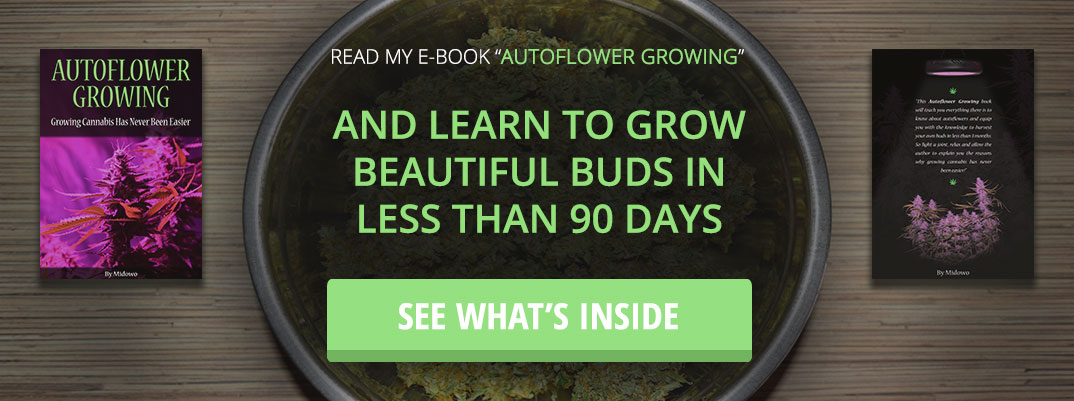What is foliar feeding?
Like most gardening terms, “foliar” comes from Latin and means “leaf” (folium”) … so “foliar” is “of the leaf” and “foliar feeding” refers to giving nutrients to the plant via the leaves. Using a fine misting sprayer you gently mist the leaves of your autoflowers with a dilute nutrient solution.
How does it work?
We all know that like all other plants, autoflowers absorb nutrients and water through the roots and we know when to give autoflower nutrients in the regular way. But it is at the leaf level that plants convert these elements into useable food and growth through photosynthesis. By applying nutrients direct to the leaf you are sending these straight to where they will be utilized!
In fact, tests show that nutrients absorbed through the stomata (on the leaf´s underside) will be found in the roots within 60 minutes. And a project conducted at Michigan State University, using radioactive tagged nutrients, proved that foliar feeding can be 8 to 10 times more effective than soil feeding.
Great! So what´s the best way to foliar feed my autoflowers?
- Use a hand sprayer/atomiser with the finest misting setting you can afford. Those stomata are literally microscopically small, and large droplets of water will just drip off the leaves
- Use your nutrient solution at 1/8 recommended dose. Because you´re feeding directly into the leaf, the risk of nutrient burn is much higher
- Ph the water to between 6.2 and 7
- Aim the spray upwards at the underside of the leaves. This is where they are more “tender” and more receptive to a foliar feed.
- Because one of the main functions of the stomata is to regulate temperature through transpiration, its important to only foliar feed when your room temps are pretty much ideal: 22C (72ºF). Let your temps creep up to 27ºC (80ºF) and the stomata (think of them like pores on your skin) begin to close and the whole exercise becomes pointless …
- Time of “day” is important too. If you are growing your autoflowers outdoors, then I would recommend foliar feeding first thing in the morning before the sun warms the day too much. AT this point the leaves are full of water collected overnight and are receptive to foliar feeds.
BUT if you are growing your autoflowers indoors (particularly if under HPS lighting) then I would suggest spraying just as the lights are about to go out (in the “evening”) as the intense heat produced by the lights can cause water scorching and damage to the leaves.
HOWEVER There is an argument that spraying at “nightfall” means the plants stay wet all night.One of the advantages to autoflowers is that it is not vital that the dark hours are kept dark. If your grow room is still quite hot when the lights are about to go off, leave the room in darkness for an hour then go back in to spray.
BE CAREFUL: Spraying liquid with electrical equipment around can be dangerous! Don´t attempt when drunk or under the influence …
- Spray leaves – top and underside until they start to drip
How often should I foliar feed my autos?
Some adherents of foliar feeding recommend doing it on a weekly basis. For these guys foliar feeding is the sure-fire way to maximize bud production later on by maximizing vegetative growth:
” most people asking about how to increase their bud size, they want the newest big bloom gutbuster on the market and run out to send large amounts of money on it. ..
Foliar Feeding is the easiest and cheapest ways to increase your size and weight,”
The argument being that the weekly direct application of nutes acts as a boost to the plant… And as we all know, the biggest buds come from sturdy, well-grown plants. Given that getting the vegetative stage of autoflowers right is so important to final yield, then a foliar feed from week 1 to 2 weeks after flowering starts really makes sure that your autos are getting maximum veg growth. It also has an additional benefit of discouraging mite problems as they don’t like the weekly application.
Some people find this weekly spraying a nuisance and an additional burden to their grow room regime. Nevertheless, you should know how to foliar feed because it can be very important. If your plants are suffering from:
- Nutrient deficiencies
- Root damage
Then you need to use foliar feeding as a means of repairing the damage done to the plants. Because the foliar feed gets directly into the plant’s system, it is an easy and quick way to correct any deficiencies the autoflowering plant is suffering from, whether as a result of pH lockout or root disease.
Note: remember to stop spraying once flowering has properly started. Not only does it increase the risk of molds and fungal infections, but you don’t want nutrient residue on the bud you’re going to be smoking.
This post was written by Campo Cultivator from Growers Guide to Cannabis








2 Comments
Hello, I am starting my first real project.
When using foliar feeding, I assume you are still providing them water with no nutes as scheduled?
I understand the reduced initial % for nutes in regards to Autos. However, how much do I need to spray on each plant 1x per week?
Thanks,
Moondude
When doing foliar feeding you can spray them with a mild nutrient solution once a week, but most common foliar feeding application is when a plant has a defficency of some sort to get those chemicals faster to the leaves.
Regular foliar feeding (spraying water on leaves) with plain water is necessary when your humidity is too low or heat is too high and then you can spray once every day.